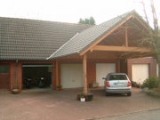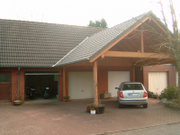
Carport
Encyclopedia

Automobile
An automobile, autocar, motor car or car is a wheeled motor vehicle used for transporting passengers, which also carries its own engine or motor...
, from the elements. The structure can either be free standing or attached to a wall. Unlike most structures a carport does not have four walls, and usually has one or two. Carports offer less protection than garages
Garage (house)
A residential garage is part of a home, or an associated building, designed or used for storing a vehicle or vehicles. In some places the term is used synonymously with "carport", though that term normally describes a structure that is not completely enclosed.- British residential garages:Those...
but allow for more ventilation.
Quoting from the Carport Integrity Policy for the Arizona State Historic Preservation Office:
As early as 1909, carports were used by the Prairie SchoolPrairie SchoolPrairie School was a late 19th and early 20th century architectural style, most common to the Midwestern United States.The works of the Prairie School architects are usually marked by horizontal lines, flat or hipped roofs with broad overhanging eaves, windows grouped in horizontal bands,...
architect Walter Burley GriffinWalter Burley GriffinWalter Burley Griffin was an American architect and landscape architect, who is best known for his role in designing Canberra, Australia's capital city...
in his design for the Sloan House in Elmhurst, Illinois (Gebhard, 1991: 110). By 1913, carports were also being employed by other Prairie School architects such as the Minneapolis firm of Purcell, Feick & ElmsliePurcell & ElmslieThe American progressive architectural practice most widely known as Purcell & Elmslie was the second most commissioned firm of the Prairie School after Frank Lloyd Wright...
in their design for a residence at Lockwood Lake, Wisconsin. In this instance, the carport was termed an “Auto Space” (Gebhard, 1991: 110). The late architectural historian David Gebhard suggested that the term “carport” originated from the feature’s use in 1930s Streamline Moderne residences (Gebhard, 1991: 107). This term, which entered popular jargon in 1939, stemmed from the visual connection between these streamlined residences and nautical imagery. In the 1930s through the 1950s, carports were also being used by Frank Lloyd Wright in his Usonian Houses; an idea that he probably got from Griffin, a former associate.
Modern carports are typically metal (steel, tin, or aluminum) and are modular in style in the USA, while remaining flat-roofed permanent structures in much of the rest of the world. Timber carports are still moderately widespread, but are frequently used as temporary solutions as opposed to metal carports which predominantly come with guarantees of up to twenty or thirty years. Aluminum carports are lightweight and can easily be assembled, giving them advantages over both wooden and steel varieties. The carport is considered to be an economical method of protecting cars from the weather and sun damage, and tens of thousands are installed in the USA alone each year.
The term carport was coined by renowned architect Frank Lloyd Wright
Frank Lloyd Wright
Frank Lloyd Wright was an American architect, interior designer, writer and educator, who designed more than 1,000 structures and completed 500 works. Wright believed in designing structures which were in harmony with humanity and its environment, a philosophy he called organic architecture...
, when he began using the carport for the first of his "Usonia
Usonia
Usonia was a word used by American architect Frank Lloyd Wright to refer to his vision for the landscape of the United States, including the planning of cities and the architecture of buildings...
n" homes; the house of Herbert Jacobs, built in Madison, Wisconsin, in 1936.
In describing the carport, he said to Mr. Jacobs, "A car is not a horse, and it doesn't need a barn." He then added, "Cars are built well enough now so that they do not require elaborate shelter." Looking back at life in 1936, it is easy to imagine automobiles prior to this time were not completely water tight; the era of robotic-assembly, advanced materials, and perfect closure lines was still 50 years in the future.
The carport was therefore a cheap and effective device for the protection of a car. Mr. Jacobs added: "Our cheap second-hand car had stood out all winter at the curb, often in weather far below zero (Fahrenheit). A carport was a downright luxury for it."

